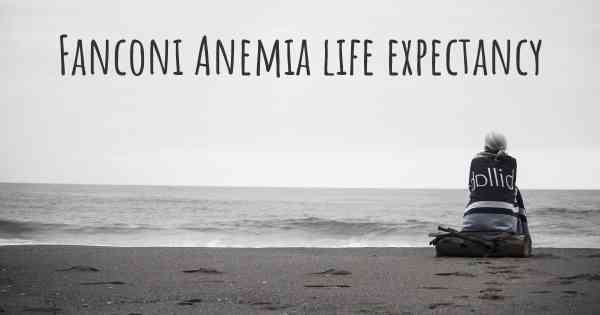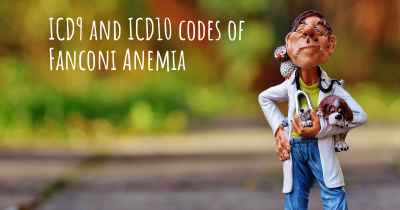What is the life expectancy of someone with Fanconi Anemia?
Life expectancy of people with Fanconi Anemia and recent progresses and researches in Fanconi Anemia

Fanconi Anemia is a rare genetic disorder that affects the body's ability to repair damaged DNA. The life expectancy of individuals with Fanconi Anemia can vary widely depending on various factors such as the severity of the condition, the presence of associated health complications, and the availability of appropriate medical care.
While it is challenging to provide an exact life expectancy, studies suggest that the average lifespan for individuals with Fanconi Anemia is around 30 to 40 years. However, it is important to note that some individuals may live into their 50s or beyond, while others may have a shorter lifespan.
Early diagnosis, regular medical monitoring, and appropriate treatment can significantly improve the quality of life and potentially extend the lifespan of individuals with Fanconi Anemia.
Fanconi Anemia (FA) is a rare genetic disorder that primarily affects the bone marrow, leading to bone marrow failure and an increased risk of developing certain cancers. It is an inherited condition, usually passed down from both parents who carry the FA gene.
Life expectancy for individuals with Fanconi Anemia can vary significantly depending on various factors such as the severity of the condition, the presence of associated complications, and the availability of appropriate medical care. It is important to note that FA is a highly heterogeneous disorder, and each case is unique.
Due to the increased risk of bone marrow failure and cancer, individuals with FA may face significant health challenges throughout their lives. Bone marrow failure can lead to a decrease in the production of red blood cells, white blood cells, and platelets, resulting in anemia, increased susceptibility to infections, and bleeding problems.
Early diagnosis and appropriate medical management are crucial in improving the quality of life and extending the lifespan of individuals with FA. Regular medical check-ups, close monitoring of blood counts, and prompt treatment of complications are essential.
Historically, the average life expectancy for individuals with FA was significantly reduced, with many not surviving beyond childhood or adolescence. However, advancements in medical care, including improved supportive therapies and the option of hematopoietic stem cell transplantation (HSCT), have had a positive impact on the prognosis of FA patients.
Hematopoietic stem cell transplantation (HSCT) is a potentially curative treatment option for FA. It involves replacing the faulty bone marrow cells with healthy stem cells from a compatible donor. HSCT can help restore normal blood cell production and reduce the risk of complications associated with FA. The success of HSCT depends on various factors, including the age of the patient, the availability of a suitable donor, and the overall health condition.
With appropriate medical management, individuals with FA can now live well into adulthood and even beyond. However, it is important to note that the long-term prognosis can still be influenced by the development of associated complications, such as solid tumors or leukemia, which may require additional treatments.
Regular follow-up care with a specialized medical team experienced in treating FA is crucial to monitor and manage any potential complications. This may include regular blood tests, imaging studies, and cancer screenings to detect and address any issues at an early stage.
It is important to emphasize that each individual's prognosis can vary, and it is not possible to provide a specific life expectancy range for someone with Fanconi Anemia. The advancements in medical care and ongoing research continue to improve the outlook for individuals with FA, offering hope for a longer and healthier life.
Posted Mar 28, 2017 by Jacy 1170
Cancers especially head and neck cancers and bonemarrow failure.
Posted Sep 22, 2017 by Jo 1920
Posted Sep 22, 2017 by Barbara 2670
My 19-year-old daughter had a transplant bone marrow Allogenic stem cell. She was seven she’s now 19. With the way her treatment plan was and how it affects her future is she is extremely high risk for MDS secondary diagnosis did you the treatment and the disease plus the genetic mutation that also connects MDS cancer probabilities and also The anemia that runs on my maternal side in general. She seems to have displayed basic symptoms of MDS secondary
Sincethw I transplant. She has thrived against all odds. I do believe she contracted Covid earlier in 2020, she’s been having ongoing basic upper respiratory issues ever since. I thought it was stress. We’re gonna do a CBC panel and I communicated with MDS cancer center and I’m waiting to hear back.
There are so many different variables do you look into and research so you can know your long-term prognosis. Since we’re finally figuring out the rest of the families hidden illnesses and the genes and the mutations I’ll connect with a variety of other specific genes that happen mutated and found with me and Cody anyway
My daughter had the one with the platelets and that also elevator service for MDS secondary cancer dude you think only anemia and mutated gene and the type of transplant and the type of donor used.
I found this all out last night while researching her symptoms and the prognosis after the transplant. Do the research. You are your advocate and you are the advocate for everyone else with this disease and similar. That’s why no one knows much about it. She will be 20 in May. And I’m very nervous so please continue to see your doctors encourage people to see doctors after the transplant even years after because it’s very possible to contract the cancer they tell you about even after thinking everything’s fine for years.
Posted Mar 2, 2021 by Danielle 210
https://www.amazon.es/ANEMIA-FANCONI-EXPERIENCIA-ENFERMEDAD-RARA/dp/1521487286/ref=sr_1_1?ie=UTF8&qid=1500408965&sr=8-1&keywords=anemia+de+fanconi
Posted Jul 18, 2017 by Elisabet 1900








